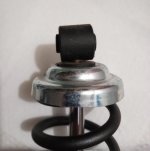As others have stated, they work together to alter the ride characteristics. The torsion bar (a.k.a. sway bar, anti-sway bar) helps to transfer load from the loaded side to its mate. The outer wheel in a turn to the inner wheel. It will corner flatter. The machine should feel more planted and controlled through corners.
Shocks, more specifically, coil over shocks, control ride stiffness and weight capacity. Too soft a spring for the load and the front end ride height will drop. Spyders are affected by bump steer: the "toe", alignment of the front wheel to the rear wheel, changes with movement of the A-arms. As the ride height drops, wheel geometry changes in the toe-out direction. Toe-out makes the bike steering feel more "twitchy" and darting. Toe-in won't have twitchiness in the steering but will wear out from tires quicker. Wheel alignment will only be right at the ride height of the bike as it was aligned; the bike should be weighted down for alignment.
Ride stiffness, along with spring rate, is affected by the damping characteristics of the shock body. If only one adjustment is on the shock, it will most often affect rebound damping only. The high-end shocks have 2 or more adjustments for independent compression and rebound damping control, and sometimes rate (hitting a bump at low speed or high speed) sensitivity.
Aftermarket shocks can be adjusted to compensate for changes in load, some more easily than others. Their basic function is spring weight (mass/displacement in either Imperial or Metric units). Ride and ride height are further affected by the amount of preload on the spring vs the load on the bike (people and cargo).
Best bang for the buck: upgrade the torsion bar. Unlimited budget and the willingness to work on the suspension settings: get both the torsion bar and performance shock upgrades. And top it all off with a proper wheel alignment for the chassis (weighted) ride height.
Shocks, more specifically, coil over shocks, control ride stiffness and weight capacity. Too soft a spring for the load and the front end ride height will drop. Spyders are affected by bump steer: the "toe", alignment of the front wheel to the rear wheel, changes with movement of the A-arms. As the ride height drops, wheel geometry changes in the toe-out direction. Toe-out makes the bike steering feel more "twitchy" and darting. Toe-in won't have twitchiness in the steering but will wear out from tires quicker. Wheel alignment will only be right at the ride height of the bike as it was aligned; the bike should be weighted down for alignment.
Ride stiffness, along with spring rate, is affected by the damping characteristics of the shock body. If only one adjustment is on the shock, it will most often affect rebound damping only. The high-end shocks have 2 or more adjustments for independent compression and rebound damping control, and sometimes rate (hitting a bump at low speed or high speed) sensitivity.
Aftermarket shocks can be adjusted to compensate for changes in load, some more easily than others. Their basic function is spring weight (mass/displacement in either Imperial or Metric units). Ride and ride height are further affected by the amount of preload on the spring vs the load on the bike (people and cargo).
Best bang for the buck: upgrade the torsion bar. Unlimited budget and the willingness to work on the suspension settings: get both the torsion bar and performance shock upgrades. And top it all off with a proper wheel alignment for the chassis (weighted) ride height.

